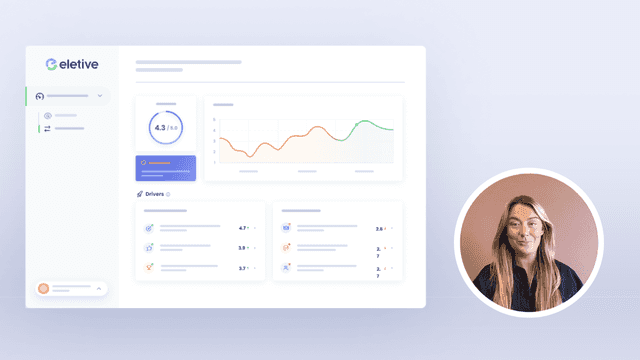Employee burnout is a serious problem that impacts individuals and organsiations in all industries. In this article, we explore some ways to lower the risk of stress-related illnesses.
Ever felt like you're running on a treadmill that just won't stop? That's what employee burnout feels like for your employees.
They run, but don't move forward.
It’s a real problem, a 2022 McKinsey Health survey reported that 25% of 15,000 workers in 15 countries experienced burnout symptoms.
But we've all been there. Working late nights, missing family dinners, and feeling constantly under pressure.
The burning question is: How can we put an end to this cycle?
This article will provide innovative tools HR managers can use to combat employee burnout; like pulse surveys, SMART goals and 360-degree feedback.
We’ll fully explore the practical steps businesses can take to not only spot the warning signs of burnout early but also prevent it from happening in the first place.
What is employee burnout?
Burnout isn't just feeling a bit tired after a long week.
It's much more severe and can have serious effects on both the individual and their workplace.
Picture an engine running at full speed for too long - eventually, it'll start to smoke and break down.
Similarly, when employees are overworked or under immense stress consistently without relief, they begin to show signs of burnout.
They may feel drained physically or emotionally with decreased motivation towards work tasks.
This mental exhaustion is not only harmful for individuals but also impacts organisational productivity significantly.
A study by Gallup revealed that burned-out employees take 13% more sick days than others; this could potentially lead to significant financial losses in companies due to lost working hours.
The World Health Organization (WHO) officially recognized employee burnout as an “occupational phenomenon” in 2019 - highlighting its prevalence and impact globally.
Causes of employee burnout
Work overload
When employees are inundated with more tasks than they can reasonably handle, it creates a constant state of stress. This unrelenting pressure eventually leads to burnout as individuals struggle to keep up with their workload.
Lack of autonomy and role control
Feeling like a cog in the machine without influence over one's workload or projects is demoralising. A lack of autonomy in one's role can breed discontentment and exhaustion, as employees feel powerless in their professional lives.
Toxic workplace culture
When employees do not receive recognition or appreciation from superiors and peers and face poor communication patterns, they often feel undervalued and unmotivated. These conditions create a fertile ground for burnout to take root.
73% of individuals who have encountered burnout attribute it to a toxic work environment according to a 2023 workplace culture report by Oak.
Lack of fair treatment
Fair treatment is vital for job satisfaction and, conversely, employee burnout. Issues such as unequal pay, unfair treatment by management, or bias among colleagues can negatively impact morale, leading to stress that fuels the cycle of burnout.
Signs of employee burnout
Suddenly, you find that your previously passionate worker is just going through the motions.
It’s a hard thing to witness, and even harder to experience.
The first telltale sign is often chronic fatigue. A person at risk of burnout may seem more tired than usual or have trouble focusing on tasks. Then there's cynicism - when employees start to feel disconnected from their work and colleagues, it's usually because burnout has set its roots.
Decreased productivity can also signal burnout. If once high-performing employees are struggling to meet deadlines or deliver quality work, something might be amiss.
Chronic fatigue: Employees seem constantly drained and struggle with focus.
Cynicism: disconnection from work and colleagues signals emotional exhaustion.
Decreased productivity: High performers suddenly unable to meet deadlines indicates burnout.
7 ways to prevent employee burnout
1. Conduct regular pulse surveys
These short, frequent check-ins give you real-time feedback on your team's mood and engagement levels.
This is important because spotting the early signs of burnout can be tricky.
Employees may seem fine on the surface but be struggling underneath. That’s where Eletive's pulse survey feature comes into play.
Eletive allows you to tap into how employees really feel about their work environment, workload, and relationships with colleagues. The results might surprise you. They also provide valuable insights that can help prevent stress from escalating into full-blown burnout.

The role of real-time feedback in burnout prevention
You wouldn't wait until your car breaks down before checking the oil level.
In much the same way, waiting until an employee shows obvious signs of strain isn’t smart or fair – to them or your business.
Mekonomen Group, an Eletive customer, saw significant improvements by implementing regular pulse surveys: better communication within teams; improved understanding between managers and staff; even increased job satisfaction rates.
Making changes based on survey results
Taking action based on what these quick surveys reveal is key. Simply having the info isn't sufficient - we need to put it into practice. This could mean adjusting workflows or responsibilities when employees flag high stress levels due to heavy workloads. Or perhaps creating more opportunities for positive team interactions if loneliness or isolation crops up in the feedback.
Learn more about how Eletive's pulse surveys can help you spot potential burnout and take action before it becomes a problem.
2. Set SMART goals and OKRs
One strategy that has proven to be effective in tackling burnout is setting SMART goals and OKRs (Objectives and Key Results).
The key idea here? It's all about alignment - aligning individual work with broader team objectives.
You see, when employees have clear expectations of what they need to achieve, the chances of them feeling overwhelmed or 'burnt out' significantly decrease. They know where their efforts are headed, reducing ambiguity which can often lead to stress.
How Eletive helps set goals
Eletive’s platform for performance management takes goal-setting seriously. We offer features specifically designed to help you establish SMART goals and track progress towards achieving these targets.
This means your teams will always know what they're aiming for.
Plus, seeing real-time updates on how well they're progressing provides a tangible sense of accomplishment – something crucial in warding off feelings of burnout.
3. Implement 360-degree feedback
360-degree feedback is a comprehensive performance evaluation method that gathers input from multiple sources within an organisation…
This includes supervisors, peers, subordinates, and even self-assessments. It provides a well-rounded view of an employee's performance.
Feedback shouldn’t be a unilateral activity, but rather an active exchange of ideas to promote employee growth.
How 360-Degree feedback mitigates burnout
All-around insights: 360-degree feedback captures feedback from various angles, revealing crucial factors like excessive workload and interpersonal challenges that can lead to burnout.
Fosters open communication: This approach nurtures a culture of open dialogue, empowering employees to voice their concerns and needs without hesitation.
Alignment with expectations: 360-degree feedback aligns individual work with team objectives, reducing the stress caused by ambiguity.
Tailored solutions: Feedback gathered through this process guides the creation of personalised solutions to address specific burnout-inducing issues.
Cultivates supportive culture: By giving employees a voice and addressing their concerns, 360-degree feedback fosters a culture where they feel valued and engaged.
In today's fast-paced workplace, employee well-being is not a luxury but a crucial investment in your company's success.
Our platform has a 360-degree feedback feature that you can check out here.
Related reading: How to give 360 feedback with examples.
4. Create action plans based on survey results
Once you've gathered insights from surveys, it's crucial to put that knowledge into action.
Let's say your team just took part in a pulse survey, and the results indicate signs of potential burnout. What next?
The answer is simple: start developing an actionable plan.
The process begins by identifying areas of concern highlighted in the pulse surveys. These could range from excessive workload to lack of recognition or even poor work-life balance.
It's vital to not only spot these problems but also comprehend what lies at their core.
Our platform makes this task easier with our platform which helps make sense out of complex data sets quickly and efficiently.
You'll be able to spot trends over time and get valuable insight into how various factors influence employee engagement levels.
Next up is crafting solutions tailored for each problem area identified through your survey results.
This might involve reducing workload, promoting peer recognition or implementing more flexible working hours depending on what you find out about your team’s needs.
Action plans should have clear objectives that align with wider company goals.
The steps towards achieving these objectives need to be concrete yet adaptable as circumstances change.
Last but not least, everyone involved must know who’s responsible for executing different parts of the plan - clarity here can prevent future misunderstandings.
You're now equipped with both insights and a roadmap – all set for taking decisive actions.
Eletive supports this journey further by connecting actions directly back to survey results, helping you measure the effectiveness of your efforts.
5. Implement a "disconnect day"
A remedy for preventing employee burnout could be the introduction of a 'Disconnect Day'.
This day allows employees to unplug from work, take time off screens, and refresh their minds. It's not just about taking a break; it's about creating an environment where mental well-being is valued.
The concept of Disconnect Days may seem counterproductive initially, but bear with us here.
Excessive toil does not result in elevated efficiency, instead it brings about amplified tension and burnout. Hence, disconnecting occasionally can rejuvenate staff morale and improve overall productivity.
In practice, you might wonder how this would look in your organisation? Let's think about making one day per week email-free or holding meetings outdoors. Encourage hobbies or physical activities during lunch breaks too.
The goal here isn't necessarily total disconnection from work – that's often impractical - but more so promoting balance within the working day.
6. Foster intrapreneurship and self-leadership
This concept, often seen as the corporate version of entrepreneurship, lets employees act like entrepreneurs within their existing organisation.
Intrapreneurs are encouraged to take ownership of projects and make decisions independently. They feel more engaged because they're given the chance to shape their work environment actively, making them less prone to burnout.
The beauty of fostering self-leadership lies not only in preventing burnout but also stimulating innovation and productivity at work. It encourages an open exchange of ideas that could potentially lead your company into exciting new directions.
To succeed with intrapreneurship, it's essential you strike a balance between autonomy and support. While letting your staff members explore innovative solutions autonomously fosters creativity, don't forget about providing guidance when needed too.
7. Leverage real-time reports and analytics
Employee burnout is a sneaky villain. It creeps in unnoticed, but when it strikes, the effects can be devastating. How do we outsmart this workplace menace? The answer lies in Eletive's real-time reports and analytics.
Our tool uses machine learning to crunch data from your team’s responses to pulse surveys. This isn't just any data - it's real-time information that allows you to track engagement levels across different teams or departments.
The beauty of these insights? They're delivered straight away. No waiting for weeks on end before making crucial decisions aimed at preventing employee burnout.
You might wonder why immediate access to this sort of data matters so much. Well, imagine trying to navigate through London without GPS – confusing right?
Eletive provides the 'GPS' you need by using advanced algorithms that sift through employee feedback, giving clear directions towards improved engagement and productivity.
Actionable insights: Get precise indications about where changes are needed within your organisation.
Predictive analysis: Foresee potential problem areas even before they become obvious problems.
Data-driven decision-making: Instead of relying on hunches or guesswork, let real numbers guide your strategies for enhancing work conditions and reducing stress levels among staff members.
Conclusion
We've now explored 7 strategies to spot and prevent burnout.
By adopting these steps and tools, you're investing in a healthier, more productive work environment.
One where everyone is happier and has the support they need to thrive.

























